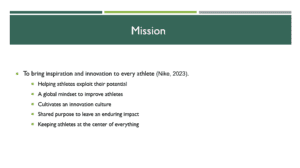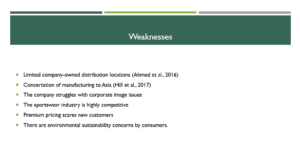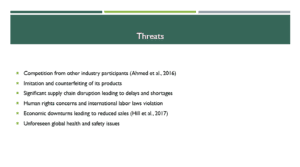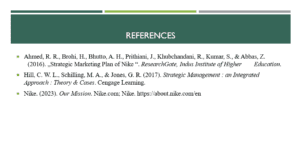Nike Inc SWOT Analysis
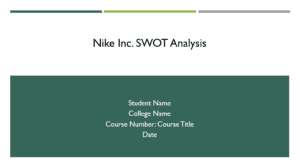
Nike’s mission is ‘To bring inspiration and innovation to every athlete.’ The company’s mission emphasizes inclusivity, implying that it focuses on a broader customer base, including people with disabilities, as long as they feel that they can compete (Nike, 2023). Another significant aspect of the company’s mission is innovation, as the company incorporates top-notch design and cutting-edge technology to enhance the athlete’s comfort, style, and performance as they chase their dreams. Consistently, Nike is not limited to just making products for profit. Instead, the company is focused on leaving an enduring impact by participating in initiatives geared toward making a difference, such as sponsoring athletes to achieve their dreams and inspiring upcoming talents. Also, the company’s global approach, including regions where its business prospects are not blossoming, shows how the company is not just interested in profits but the greater good and making impactful contributions to all sportsmen and women.
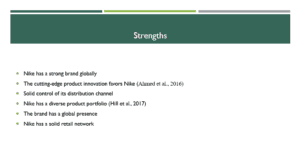
Nike Inc. continues to contend with its lack of company-owned distribution channels. As a result, it has to partner with external retailers to distribute its products. The external partners may influence pricing upward, hence, likely to scare away potential customers (Ahmed et al., 2016). Besides, the company’s manufacturing plants are concentrated in Asia, specifically China. Adverse economic changes in these regions will likely affect production and hurt the company’s global business. Besides, Nike has faced corporate image issues, such as labor controversies in its contracted factories (Hill et al., 2017). A poor corporate image harms a company’s reputation and will likely cause consumer backlash. The stiff competition in the sports apparel industry from competitors New Balance and Adidas also pushes the company to invest heavily in research and development to gain a competitive edge. Such competition leaves the company with little to invest in other equally important initiatives, such as athlete sponsorship, which is equally vital. Further, premium pricing at Nike tends to scare away potential customers. Although such pricing appeals to price-insensitive consumers and big brands, new price-sensitive consumers tend to be scared. The other issue that affects the company’s reputation adversely is concerns about environmental sustainability. Although Nike has made efforts to improve in this area, there are concerns that reliance on products like cotton pollutes the environment.

Nike faces competition from industry participants such as Puma, New Balance, and Adidas (Ahmed et al., 2016). When a company faces such threats, it has no option but to invest heavily in research and development. That poses operational challenges since the company is left with limited resources to undertake other business activities. Another significant threat is the manufacture of counterfeits and imitation by other players. Counterfeits are sold at relatively lower prices, threatening Nike’s market share. Further, supply chain disruptions due to geopolitical factors affect production, leading to product delays and shortages. For instance, the recurring US-China trade wars threaten to disrupt the company’s production hub in China (Hill et al., 2017). Human rights concerns about employee treatment in the company’s factories also exist. If left unattended, these issues threaten to cause consumer apathy. Also, economic downturns globally reduce consumers’ purchasing power, leading to reduced sales by the company. Another significant threat is associated with unforeseen global health and safety issues. For instance, the recent COVID-19 pandemic and the regulations afterward, such as banning flights, disrupted the company’s supply chain network.
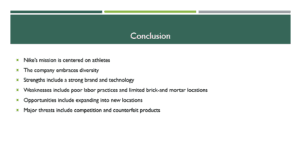
Ahmed, R. R., Brohi, H., Bhutto, A. H., Prithiani, J., Khubchandani, R., Kumar, S., & Abbas, Z. (2016). „Strategic Marketing Plan of Nike “. ResearchGate, Indus Institute of Higher Education.
Hill, C. W. L., Schilling, M. A., & Jones, G. R. (2017). Strategic Management : an Integrated Approach : Theory & Cases. Cengage Learning.
Nike. (2023). Our Mission. Nike.com; Nike. https://about.nike.com/en
ORDER A PLAGIARISM-FREE PAPER HERE
We’ll write everything from scratch
Question

Nike Inc SWOT Analysis
A SWOT Analysis is used to evaluate the strengths, weaknesses, opportunities and threats for a business. This analysis can be used to help in the creation of strategic plans for the future. You will perform a SWOT Analysis for a real-world organization and complete your assignment as a PowerPoint presentation.
Instructions:
Choose a real-world organization.
Perform a SWOT Analysis on the organization, creating a PowerPoint with your results. Follow this format:
- Slide 1: Title slide with your name and the organization’s
- Slide 2: Mission of the
- Slide 3: Explain 4 to 6 strengths of the company (add more slides if needed).
- Slide 4: Explain 4 to 6 weaknesses of the company (add more slides if needed).
- Slide 5: Explain 4 to 6 opportunities of the company (add more slides if needed).
- Slide 6: Explain 4 to 6 threats for the company (add more slides if needed).
- Slide 7: Your conclusion. Provide your opinion on the strategic position of the organization based on the findings of your
- Slide 8: Reference
Requirements:
- Create a PowerPoint presentation, at least 8
- Include at least 2 valid, credible
- Use APA formatting for citations, include in-text citations on

